Thought leaders often build a big body of work on their own sites, but they don’t just stop there. Returning readers continue to enjoy their high value content, but thought leaders want to share their expertise with other relevant audiences.
Enter guest blogging.
Building Your Guest Blogging Process
What Is Guest Blogging?
Guest blogging has been around a long time. The name itself is pretty self-explanatory.
As a writer, you’re contributing an original piece of content to be published on a site that is owned by another company or person. You typically get a short author bio, a headshot, and a link to your site.
It’s an essential piece of successful content marketing strategies.
Why Guest Blogging Matters
Critics suggest the SEO value of guest blogging is long dead. Matt Cutts, Google’s former head of web spam, dropped this bombshell on the content marketing world way back in 2014:
“Okay, I’m calling it: if you’re using guest blogging as a way to gain links in 2014, you should probably stop.”
Notice the language he uses here. “As a way to gain links” should not be your primary motivation. While backlinks are definitely a major benefit, you’re really striving to deliver targeted, high value content first and foremost.
High value, kickass content wins big in the guest blogging world, and the other side of the spectrum – the spammy, link-stuffed, thin content is what’s dying.
As a quick overview, these kinds of guest blogs are dead:
- Content that is irrelevant to the outlet’s audience.
- Content that doesn’t fit guest blogging guidelines.
- Content that is misaligned in tone and style from the outlet.
- Content that can be considered a “spun article.”
- Content stuffed with bad links or overly promotional links.
- Content that is completely devoid of links.
When you create great guest posts, you can reap the many benefits, such as:
Building Brand Awareness With New Audiences
Industry blog readers will take note of you and your brand when they are impressed by your content. This is especially true if you’re linking to your company blog and providing high value resources that are branded, like an infographic or original research report.
Demonstrating Credibility and Earning Trust With New Readers
These new audiences fall under the off-site thought leadership portion of the funnel, as illustrated in Kelsey Meyer’s Content Marketing Institute blog post.
Source: Content Marketing Institute
As you can see, it fits into the early stages of engagement between thought leaders and readers.
When readers of industry-specific blogs gain valuable insights from an article they find, they don’t just stop reading. In fact, many readers may become fast fans of your work and dig deeper into your existing body of content.
Earning Quality Backlinks to Boost Your SEO
You aren’t writing guest posts primarily for backlinks. The links you earn are purely incidental, but that doesn’t mean they don’t help boost your SEO efforts.
Plus, you can get linked when the outlets share your post via social. It's an added bonus when readers also link to your guest post in their shares.
Developing Mutually Beneficial Relationships With Other Webmasters
When it comes to creating a sustainable link building and SEO strategy, you can’t give the surface level details (like links, follows, etc.) all your attention.
Your primary focus should always be building and maintaining relationships. This opens doors for a continuous supply of guest blogging opportunities, especially if you deliver high value content consistently.
Driving Referral Traffic to Your Site
A strong guest post will entice readers to check out your site, which they likely find in your author bio. They might be interested in more of your blog content or, even better, your lead magnets.
Establishing Your Guest Blogging Process
So should you just start randomly emailing the powerhouses in your industry? Does cold emailing land you a guest column on Forbes?
Hell no.
Let’s take a step back and talk about process. Your content team’s guest blogging efforts need a process to streamline your ideation, creation, pitching, and analysis.
Here’s what your process should include:
1. Establish Your Goals With Guest Blogging Campaigns.
Your guest blogging campaigns need goals, as with every marketing initiative. Your goals may vary. For example, your goal might be one of the following:
- Drive traffic to a specific page (like a landing page or a blog post).
- Earn high authority backlinks from high value outlets.
- Get cited by other thought leaders.
- Boost social media engagement on your channels.
2. Build Your List of Targeted Sites.
Once you have your goals in place, it’s time to target the best outlets for your guest posts. As you’re researching guest blogging opportunities, you need to confirm the three R’s:
- Relevant - Is the site relevant to your business? Will their audience find your content relevant to them?
- Respected - Is the site an authority in the industry? Check their authority, either using domain authority or domain rating as your metric for credibility.
- Ready - Is the site accepting guest posts at the time? Look for guidelines and submission information.
3. Develop Relationships With Site Owners.
This is your outreach, where you first earn attention from webmasters and site owners of domains you want to be published on.
Here are a few ways to get on their radar:
- Follow them on social.
- Share their content.
- Comment on their blogs.
- Tag and cite them in your shares.
- Mention their content in your content and link to them.
Remember, you’re not just connecting for one guest post placement and then moving on. You want to plant the seeds and grow a sustainable relationship that leads to more opportunities down the road.
Here are some best practices for building these relationships at the start:
- I will say it again: Read their guest submission guidelines. If you don’t, you’re committing a huge mistake that will diminish your chances of being published.
- Send personalized messages when you reach out. Use their name, mention specific things you like about their content, and be genuine.
- Share your why and show your work to prove expertise. Most webmasters and content managers get bombarded with cold outreach all day long. Stand out by detailing a unique purpose behind why you’re connecting with them.
4. Pitch Ideas or Completed Posts.
At this point, you should have some back and forth with your contact at a target outlet. This positions you to improve your chances of being placed because now you have an established, respectful relationship with them.
When you’re pitching guest blog content ideas, you don’t want to simply throw random or half-cooked ideas to your contact. You want to wow them.
Find popular topics they’ve already covered and look for gaps that you can fill with your unique insights. You can also research up-and-coming trendy topics that are about to explode in popularity.
And don’t just accept silence. You often don’t get prompt responses because webmasters and content managers are busy fielding many of these requests. You can stand out with awesome ideas, then set up scheduled follow-up messages.
Think of following up as respectfully nudging them for a response. In these follow ups, you can re-emphasize the value your guest post can bring to the blog and to their audience.
5. Write and Submit Your Awesome Post.
Once your idea is approved, get to writing! Have your internal team proofread it and get it “publish ready.” Then, celebrate and send it to your contact!
Expect some feedback and maybe even some edits. They might have already given you a slot in their editorial calendar, so be prompt in making your updates to avoid leaving them waiting on you.
How to Find Guest Blogging Opportunities
There are plenty of opportunities waiting for you, but without the proper direction, you’re going to continually overlook them. Fortunately, there are a slew of methods for finding outlets that are accepting guest posts.
The Easy (and Free) Ways
via GIPHY
Advanced Search Queries
Turn to search engines and use the following variations of these queries:
- [topic] “write for us”
- [topic] “become an author”
- [topic] "guest post"
- [topic] “guest article”
- [topic] inurl: contribute
These queries can help you sift through all the outlets in your industry to find a list of domains that are ready for guest pitches.
Reverse Image Search
You can use image search and work backward to uncover opportunities that fit your interests. Here are the steps to follow:
- Identify a thought leader in your niche who writes a lot of guest posts.
- Copy the URL from their headshot used in their author bio.
- Search by image in Google to find all the places they’re published.
You can start throwing your hat into the ring with these outlets you find. Getting published alongside other thought leaders can show exactly how credible you are within your field of expertise.
Aggregators
There are some great aggregator sites you can use to center in on blogs unique to your industry. Some of the best options include:
- AllTop – You can search by category and get hyper focused in your search for industry blogs.
- MyBlogGuest – Join this community to find opportunities and network with relevant blog owners.
The More Involved (and Not Free) Ways
We are big fans of Ahrefs, and while their platform comes at a cost, it’s incredibly powerful, especially for finding guest blogging opportunities in a variety of ways.
Stalking People
Yes, you read that right. You can stalk people online to find guest blogging opportunities.
With Ahrefs, you're able to find where your competitors are guest blogging, then reach out to each of those outlets. To find this, follow these simple steps:
1. Fire up Content Explorer.

2. Use the following query: "author: Author name." In this example, we are looking up Neil Patel, one of the biggest influencers in the world of marketing.
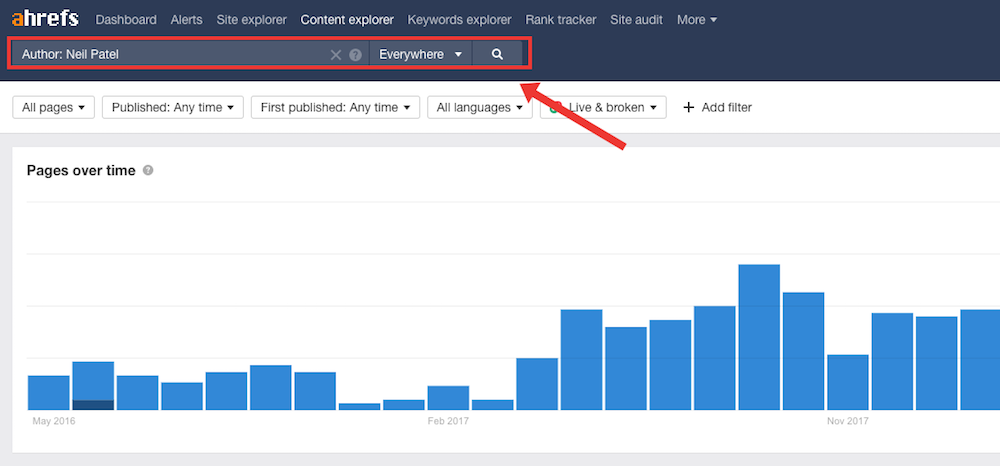
3. Click the "one page per domain" toggle to narrow your search.
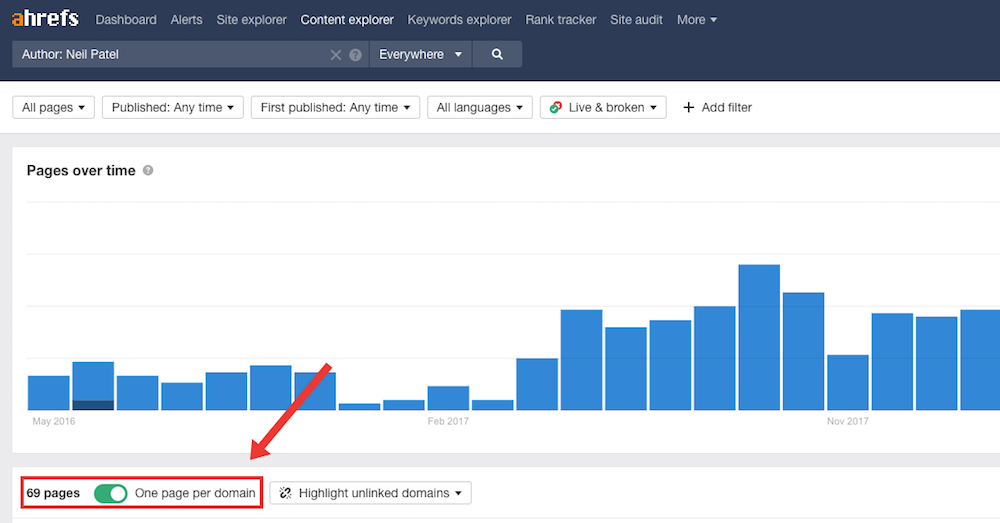
In this example, when I select one page per domain, it reduces the results from 807 pages (Neil is clearly very prolific!) to 69 pages, showing outlets he contributes to.
4. Sift through the results and make your list of outlets you want to submit to.
Note: You will have to manually go through this list, so it might take you some time. But in the end, you're left with a solid list of relevant outlets that accept guest posts.
Aiming at More Realistic Targets
This is a great tactic if you’re just starting to pitch guest posts.
1. Get Content Explorer up and running.
2. Search a keyword you’re looking to write about. In this example, we are looking at "inbound marketing."
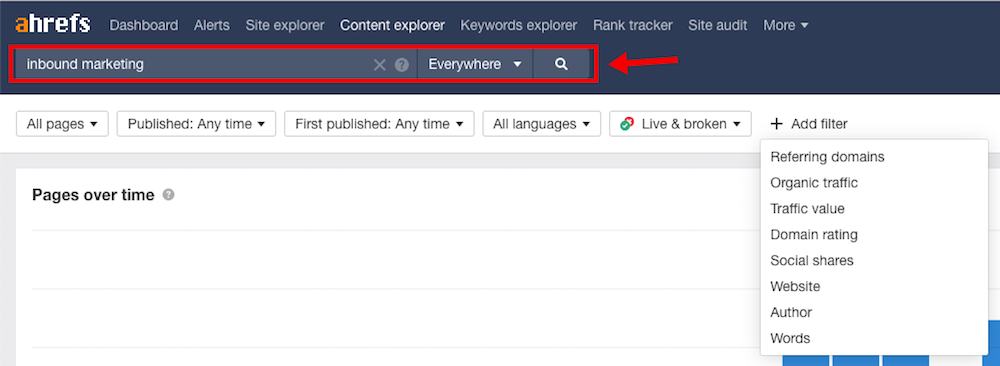
3. Set a filter for domain rating. For example, set the maximum DR to 40, then hit "Apply" and hit the "one page per domain" toggle to narrow your search.

4. Voila! You have a list of websites that likely experience a much lower volume of guest post pitches. Therefore, when you pitch, they’re more likely to respond and (hopefully) accept your post.
Bonus: The Lazy Way
These techniques are helpful when building your guest blogging opportunity database. However, other writers have already done this for you!
Search through existing resources that break down lists of websites accepting guest posts. Here are some resources to check out:
- Solvid’s List of 300+ Websites/Blogs That Accept Guest Posts & Contributions
- Writers In Charge’s The Definitive List of Blogs That Accept Guest Posts
- WebsiteHostingRating.com’s List of 200+ Websites & Blogs That Accept Guest Posts
- Advanced Web Ranking’s 150+ Sites to Guest Post in 2019
- OutReachMama’s List of 700+ Guest Posting Sites for 2019 (Updated)
Guest Blogging Techniques
There are a few super cool techniques you can use to streamline how your team ideates and creates guest posts.
Taking a New Perspective
Adjust the perspective of some of your existing posts slightly by getting hyper focused on smaller topics.
Let's say you're writing a guest post on SEO challenges. You can generate other individual posts by aligning that idea with specific industries, like non-profits, manufacturers, or startups with limited resources.
This shift in perspective makes the guest post content more granular and (ideally) more valuable for certain audiences.
Becoming Robin Hood
“Steal” great content from super popular blogs and deliver them to lower ranked blogs with less traffic and authority. By steal, we mean let it inspire and shape your content. Do not by any means plagiarize!
Follow these steps for "Robin Hood-ing" guest content:
1. Check high-DR blogs in Content Explorer. In this example, we are looking at Search Engine Journal, a leading SEO blog.
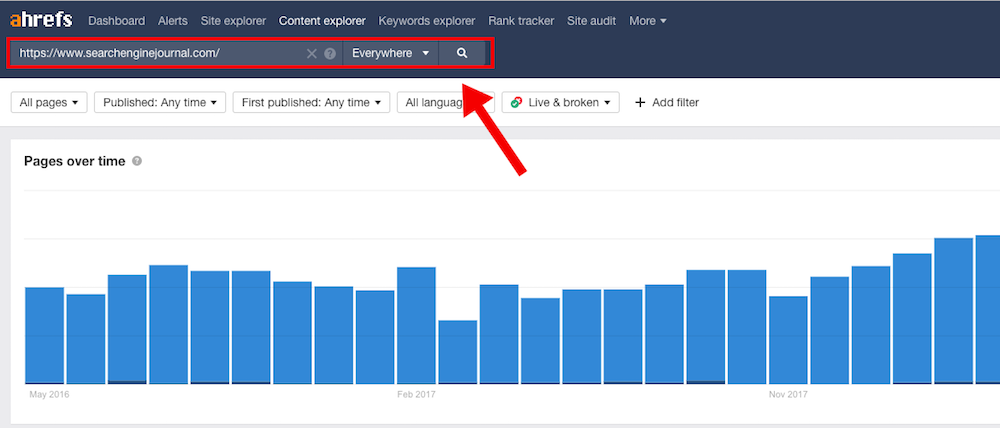
2. You can sort results to see what posts generate big results. Choose one of the following:
- Total shares (all social shares)
- Organic traffic (visitors finding content via search)
- Referring domains (backlinks earned)
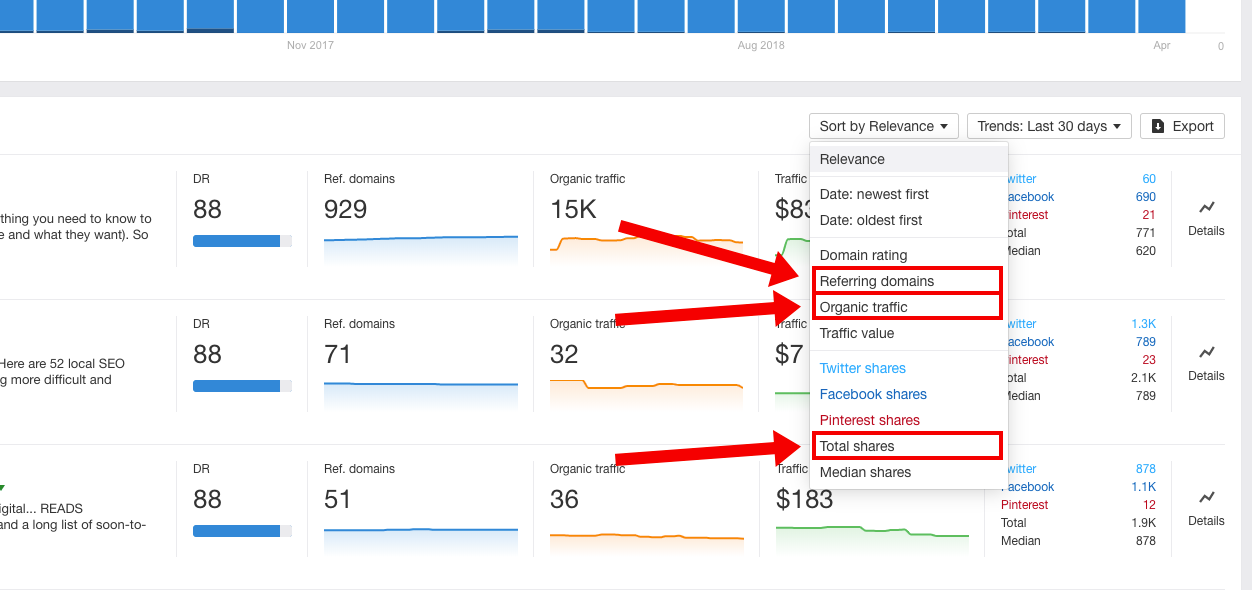
3. Read the top performing content to get an idea of what to write about, then add your unique spin on the post and write your own to pitch to lower tier blogs.
With a cool new angle, you can really impress these webmasters who are looking to earn backlinks from high authoritative sites.
Splintering Your Content
Break long form content into “splinter” sections that can be built out and stand alone as an individual post. This process is as simple as a few steps:
- Find a long-form post you already have on your blog.
- Write individual posts on each “chapter.”
- For example, our long-form post on the new domain authority can be splintered into the following individual posts:
- How to Remove Bad Backlinks From Your Site
- Why Improved User Experience Matters to Your DA
- X Ways to Use MozBar for SEO Strategies
- For example, our long-form post on the new domain authority can be splintered into the following individual posts:
This approach is also great for you as a thought leader to dive deeper on certain subtopics related to a broader topic.
Measuring Your Guest Blogging Success
How you measure success depends on what your guest blogging goals are. Here are a couple of analysis strategies to use for each type of goal.
Engagement
If your focus of your guest blogging campaign was strictly to generate engagement on a website, you can measure both on-page and off-page engagement. On page, you can look at the blog comments section to see if readers are having meaningful discussions.
For the off-page engagement metrics, look at social media shares. Tools like BuzzSumo make this easy. You can see how your content shares stack up to other guest posts on a particular outlet.
Their Chrome extension shows you social engagements on any page with one click. You can also analyze other important metrics, like top performing content from authors (like you vs. other thought leaders) and backlinks earned.
Backlinks
Speaking of backlinks, you can measure the links you earn over time with several SEO tools like Moz, SEMRush, and, you guessed it, Ahrefs.
In their backlink profile reports, you can look at new backlinks and new referring domains. This is where you can see the fruits of your labor.
Traffic
Naturally, your guest blogging efforts will lead to referral traffic. This is where Google Analytics is super valuable. You can create an advanced segment within your portal.
For each domain you submit a guest blog to, add the source dimension for one segment and include the domain in it. This way, you see the traffic coming from each outlet.
With the right guest blogging process in place, you and your content team are ready to hit the ground running. New readers are waiting to discover you and your expertise. Are you ready to share your awesome insights? Get to it!



Jeff Previte
I am a Content Manager at Bluleadz. I enjoy spending time outdoors -- camping, hiking, hammocking, and everything in between. I also love reading, writing, and learning how to play guitar.